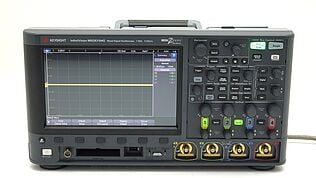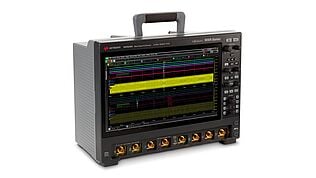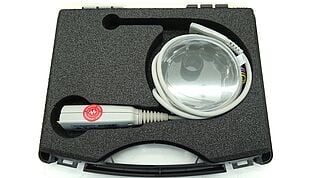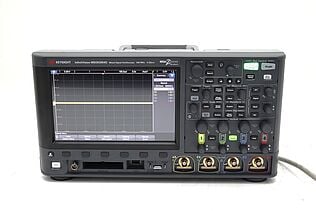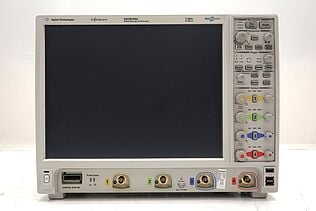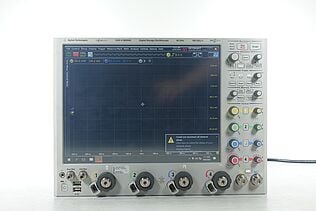- Introduction
- What Are Limit Lines?
- Why Do We Need Limit Lines?
- Fast Pass/Fail Testing
- Quality Control
- Enhanced Visualization
- Types of Limit Lines
- Upper Limit Line
- Lower Limit Line
- How to Set Limit Lines on Oscilloscopes?
- Application of Limit Lines in Various Tests
- Signal Integrity Tests
- Emission Tests
- Timing Tests
- Quick Glance at Limit Lines
- Conclusion
- Whenever You’re Ready, Here Are 5 Ways We Can Help You
When driving there are many guidelines to follow to help you get to your destination safely. For example, there are lines on the road that indicate where you should drive. These will help you to stay on the right side of the road and avoid colliding with oncoming traffic.
In the world of electronic testing, it's the limit lines that act as these vital boundaries, ensuring our devices operate with precision and accuracy. Join us as we delve into the essential world of limit lines in electronic testing.
What Are Limit Lines?
Limit lines define the acceptable boundaries for signal characteristics during testing. When you measure an electronic signal using an oscilloscope or any testing equipment, these lines help in quickly determining whether the signal is within the specified limits or not.
| Key Takeaway |
|---|
| Limit lines in electronic testing act as essential boundaries, ensuring signals adhere to desired standards and specifications, thereby guaranteeing optimal device performance and reliability. Their application across various tests underscores their significance in maintaining the integrity and safety of electronic devices. |
Why Do We Need Limit Lines?
Limit lines serve as a quintessential tool in the electronic testing realm. Let's delve deeper into their importance:
Fast Pass/Fail Testing
- Instant analysis: With limit lines, engineers no longer need to scrutinize every detail manually. A glance will tell whether the device is up to the mark.
- Efficiency boost: Time is of the essence, especially in mass production. Limit lines speed up the testing phase, enabling quicker transitions from design to market.
Quality Control
- Uniform standards: One of the challenges in electronic manufacturing is maintaining consistency. Limit lines act as set standards across multiple units.
- Reduced rework: With immediate detection of anomalies, the need for post-production corrections drops, saving both time and resources.
- Enhanced reliability: Consumers trust brands that offer consistent quality. Limit lines play a pivotal role in building and maintaining this trust.
Enhanced Visualization
- Intuitive display: On an oscilloscope, limit lines not only set boundaries but also create a clear distinction between normal and abnormal signal behaviors.
- Historical comparison: By juxtaposing current signals with past references, engineers can assess whether a component's performance is improving or deteriorating.
- Informed decision-making: The clearer the data representation, the quicker and more accurate the decisions. By vividly highlighting signal deviations, limit lines empower engineers to make on-the-spot adjustments.
Get Keysight Oscilloscopes on Sale Now
Types of Limit Lines
In the intricate world of electronic testing, limit lines serve as the defined boundaries for signal behavior. Let's dive into the two primary types that shape the foundation of this realm:
Upper Limit Line
The upper limit line stands as a guardian, ensuring signals don't cross into the territory of excessive values.
- Anomaly detection: One of the primary roles of the upper limit line is to alert testers to unexpected spikes or excessive values in the signal.
- Protection against overloading: In scenarios where electronic components might get damaged due to excessive values, this line serves as a warning marker.
- Consistency in output: Devices often have a maximum threshold for optimal performance. The upper limit line ensures that this threshold remains unbreached, guaranteeing consistent output quality.
Lower Limit Line
The lower limit line, in contrast, ensures that signals don’t fall short of their expected values.
- Guard against weak signals: A signal that's too weak can be just as problematic as one that's too strong. This line quickly identifies such underperforming signals.
- Ensure minimum performance standards: In many electronic components, there’s a baseline performance level required for satisfactory operation. The lower limit line ensures components meet or exceed this level.
- Aids in calibration: When calibrating devices, especially in RF applications, the lower limit line assists testers in ensuring that the device operates within the necessary range. This aids in maintaining the quality and reliability of communication systems.
How to Set Limit Lines on Oscilloscopes?
Setting up limit lines on oscilloscopes is crucial for precise and efficient testing. Let's delve deeper into the steps to make this process clear and intuitive:
Select the Appropriate Mode:
Customization to needs: Most advanced oscilloscopes provide various modes tailored for different types of tests. By selecting the limit test mode, you’re priming the device for precise boundary-based analysis.
Ease of access: Modern oscilloscopes often have intuitive user interfaces that allow engineers to swiftly navigate to the required mode, making the setup process seamless.
Choose Reference Waveforms:
Benchmarking: The essence of effective testing is to compare the unknown with the known. Reference waveforms, derived from devices known to operate optimally, serve as the benchmark against which other devices are tested.
Flexibility in selection: Some oscilloscopes offer the advantage of storing multiple reference waveforms. This is especially useful when working on various projects or product lines simultaneously.
Define the Limits:
Manual input: For engineers who know the exact specifications and want greater control, manually defining the limits on the oscilloscope is the ideal choice.
Automated precision: On the other hand, using software utilities to auto-generate limits based on reference waveforms ensures precision. This feature is particularly handy when dealing with complex waveforms or when there's a need to replicate the setup across multiple oscilloscopes.
Start Testing:
Real-time monitoring: With the limit lines set, the oscilloscope continually checks the input signals against these boundaries. Any deviation becomes immediately apparent, facilitating quick corrective actions.
Data logging: Some oscilloscopes log instances when the signal breaches the set limits. This not only aids in identifying recurring issues but also helps in long-term analysis and improving the design or manufacturing process.
Visual alerts: To make anomalies unmissable, many oscilloscopes use color coding or flashing indicators. This ensures that even a fleeting breach doesn't go unnoticed.
Application of Limit Lines in Various Tests
Limit lines are versatile tools that find application across a spectrum of tests in the electronics domain. Their adaptability and precision have made them indispensable in several scenarios. Let's explore their significance in some common tests:
Signal Integrity Tests
- Guardians of quality: In essence, signal integrity tests aim to ensure the quality and reliability of signals. Limit lines play a pivotal role by setting the acceptable boundaries for signal parameters like amplitude, noise, and distortion.
- Spotting distortions: With limit lines, engineers can swiftly identify anomalies such as jitters, noise, and interference that might corrupt the signal.
- Enhanced device longevity: Ensuring that signals remain within their defined limits often translates to less stress on electronic components, potentially increasing their lifespan.
Emission Tests
- Compliance with regulations: RF devices need to adhere to strict emission standards set by regulatory bodies. Limit lines act as the first line of defense, ensuring that devices don't breach these standards.
- Minimizing interference: In a world cluttered with RF devices, it's crucial to ensure one device doesn't interfere with another. By setting strict limits on emission levels, devices can coexist without causing disruptions.
- Safety implications: Over-emission can also have health implications, especially in devices used close to the human body. Limit lines help ensure that devices remain within safe boundaries.
Timing Tests
- Digital pulse checks: In the digital realm, timing is everything. Limit lines can instantly show if a signal is transitioning too early or too late, ensuring the proper functioning of digital circuits.
- Synchronization: Especially in systems that rely on multiple components working in harmony, limit lines ensure that all signals are perfectly synchronized, preventing system crashes or malfunctions.
- Optimizing performance: Even minor timing misalignments can degrade a system's performance. By adhering to the boundaries set by limit lines, devices can operate at their peak efficiency.
Quick Glance at Limit Lines
| Characteristic | Importance | Type |
| Maximum Value | Ensures signal doesn't exceed permissible levels | Upper Limit |
Minimum Value | Ensures signal doesn't drop below required thresholds | Lower Limit |
| Application | Signal Integrity, Emission, Timing | Both Types |
On Sale Now: Keysight Used Oscilloscopes
Select up to 3 instruments to compare
Enable Notifications
In order to use this feature, you need to enable notifications.
Manage notification preferences
Conclusion
In the world of electronic testing, limit lines serve as the crucial boundaries that ensure signal accuracy, safety, and performance. They play a pivotal role in upholding the standards of electronic devices, ensuring that they function optimally and consistently across a myriad of applications.
For accurate and efficient utilization of limit lines, it's essential to have equipment that you can rely on. Keysight Used Equipment Store offers just that. Their premium used oscilloscopes, spectrum analyzers, power supplies and meters represent the pinnacle of precision and reliability, ensuring that professionals can trust their measurements and analyses.
If you're keen to step up your testing capabilities, don't hesitate to check out Keysight Used Equipment's Stores wide range of options.
Act now and ensure every measurement counts!

Whenever You’re Ready, Here Are 5 Ways We Can Help You
- Browse our Premium Used Oscilloscopes.
- Call tech support US: +1 800 829-4444
Press #, then 2. Hours: 7 am – 5 pm MT, Mon– Fri - Talk to our sales support team by clicking the icon (bottom right corner) on every offer page
- Create an account to get price alerts and access to exclusive waitlists.
- Talk to your account manager about your specific needs.



